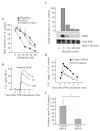Purinergic signaling: a fundamental mechanism in neutrophil activation
- PMID: 20530802
- PMCID: PMC4209711
- DOI: 10.1126/scisignal.2000549
Purinergic signaling: a fundamental mechanism in neutrophil activation
Abstract
Efficient activation of neutrophils is a key requirement for effective immune responses. We found that neutrophils released cellular adenosine triphosphate (ATP) in response to exogenous stimuli such as formylated bacterial peptides and inflammatory mediators that activated Fcgamma, interleukin-8, C5a complement, and leukotriene B(4) receptors. Stimulation of the formyl peptide receptor (FPR) led to ATP release through pannexin-1 (panx1) hemichannels, and FPRs colocalized with P2Y2 nucleotide receptors on the cell surface to form a purinergic signaling system that facilitated neutrophil activation. Disruption of this purinergic signaling system by inhibiting or silencing panx1 hemichannels or P2Y2 receptors blocked neutrophil activation and impaired innate host responses to bacterial infection. Thus, purinergic signaling is a fundamental mechanism required for neutrophil activation and immune defense.
Conflict of interest statement
Figures







Similar articles
-
Adrenergic receptor activation involves ATP release and feedback through purinergic receptors.Am J Physiol Cell Physiol. 2010 Nov;299(5):C1118-26. doi: 10.1152/ajpcell.00122.2010. Epub 2010 Jul 28. Am J Physiol Cell Physiol. 2010. PMID: 20668211 Free PMC article.
-
A novel receptor cross-talk between the ATP receptor P2Y2 and formyl peptide receptors reactivates desensitized neutrophils to produce superoxide.Exp Cell Res. 2014 Apr 15;323(1):209-217. doi: 10.1016/j.yexcr.2014.01.023. Epub 2014 Feb 1. Exp Cell Res. 2014. PMID: 24491917
-
Besnoitia besnoiti-induced neutrophil clustering and neutrophil extracellular trap formation depend on P2X1 purinergic receptor signaling.Front Immunol. 2023 Oct 3;14:1244068. doi: 10.3389/fimmu.2023.1244068. eCollection 2023. Front Immunol. 2023. PMID: 37854595 Free PMC article.
-
The participation of plasma membrane hemichannels to purinergic signaling.Biochim Biophys Acta. 2013 Jan;1828(1):79-93. doi: 10.1016/j.bbamem.2012.01.002. Epub 2012 Jan 12. Biochim Biophys Acta. 2013. PMID: 22266266 Review.
-
Purinergic Regulation of Neutrophil Function.Front Immunol. 2018 Mar 1;9:399. doi: 10.3389/fimmu.2018.00399. eCollection 2018. Front Immunol. 2018. PMID: 29545806 Free PMC article. Review.
Cited by
-
Adenosine arrests breast cancer cell motility by A3 receptor stimulation.Purinergic Signal. 2016 Dec;12(4):673-685. doi: 10.1007/s11302-016-9531-6. Epub 2016 Aug 30. Purinergic Signal. 2016. PMID: 27577957 Free PMC article.
-
The UDP-sugar-sensing P2Y(14) receptor promotes Rho-mediated signaling and chemotaxis in human neutrophils.Am J Physiol Cell Physiol. 2012 Sep 1;303(5):C490-8. doi: 10.1152/ajpcell.00138.2012. Epub 2012 Jun 6. Am J Physiol Cell Physiol. 2012. PMID: 22673622 Free PMC article.
-
Pannexin1: insight into inflammatory conditions and its potential involvement in multiple organ dysfunction syndrome.Front Immunol. 2023 Aug 30;14:1217366. doi: 10.3389/fimmu.2023.1217366. eCollection 2023. Front Immunol. 2023. PMID: 37711629 Free PMC article. Review.
-
Abandon the mouse research ship? Not just yet!Shock. 2014 Jun;41(6):463-75. doi: 10.1097/SHK.0000000000000153. Shock. 2014. PMID: 24569509 Free PMC article.
-
The pannexins: past and present.Front Physiol. 2014 Feb 19;5:58. doi: 10.3389/fphys.2014.00058. eCollection 2014. Front Physiol. 2014. PMID: 24600404 Free PMC article. Review.
References
-
- Nussler AK, Wittel UA, Nussler NC, Beger HG. Leukocytes, the Janus cells in inflammatory disease. Langenbecks Arch Surg. 1999;384:222–232. - PubMed
-
- Waugh J, Wilson C. The interleukin-8 pathway in cancer. Clin Cancer Res. 2008;14:6735–6741. - PubMed
-
- Capra V. Molecular and functional aspects of human cysteinyl leukotriene receptors. Pharmacol Res. 2004;50:1–11. - PubMed
Publication types
MeSH terms
Substances
Grants and funding
LinkOut - more resources
Full Text Sources

